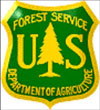
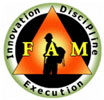
The Review of Fire Suppression Doctrine for the USDA Forest Service
MARCH 30, 2005
Ed Hollenshead – National Fire Operations Safety
Officer
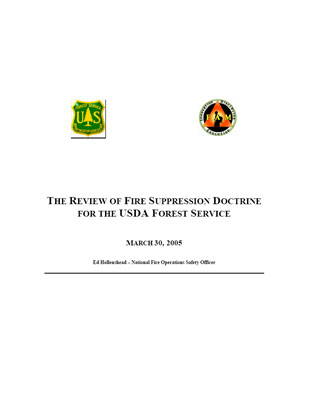
Executive Summary
Issue: Improving wildland fire suppression
operations safety and performance through review, modification, and illumination
of doctrinal principles.
Proposal:
(1) Review agency doctrine
guiding the wildland fire suppression mission
(2) Adopt and apply doctrine
to improve firefighter effectiveness and safety
Background: In the last several years the Forest Service
has come under enormous scrutiny in its performance of the wildland fire
suppression mission. Fire and aviation operations safety, fire suppression
expenditures, and accountability for decisions and procedures have all
been brought into question. The Agency responses have largely been tactical,
without clear anchoring to well understood foundational principles, or
doctrine. This approach has contributed to a layering-on of prescriptive
policies, confusion and frustration in the firefighting workforce, and
inconsistency in the Agency approach to and understanding of its fire
suppression mission.
Key Points: The fundamental issue facing
the wildland fire suppression mission is the lack of clear, commonly understood
foundational and operational doctrine. Because the Agency has not clearly
articulated doctrinal principles in wildland fire suppression, it has
no consistent basis for its actions or responses.
Agency reaction to fireline tragedies and unfavorable cost
performance reviews has been focused on the specifics of each individual
tragedy or instance, and resulted in the addition of scores of new requirements
(prescriptive policies) for fire suppression operations activities. The
intent of these actions has been to correct operational error in fireline
decision-making, leadership, and fire operations oversight, but bad outcomes
are still occurring, efficiencies continue to erode, and Agency leadership
is progressively more frustrated.
Without clear doctrine, policies and principles are viewed
as interchangeable. They are not. Doctrine is the body of principles,
the foundation of judgment, decision-making, and behaviors that guides
the actions of the organization and describes the environment in which
they are taken. It is developed from the legal and ethical mandate of
the organization, and the intent of its senior leaders. Policy is the
body of rules that guide the objective parts of the mission, and serves
as the structure used to put doctrinal principles into action. (See Attachment
1). Doctrine provides guidance for dealing with the subjective, dynamic
parts of the mission element that rely on interpretation, judgment, and
agility. Policy does not require, nor does it benefit from interpretation
or discretion. When so designed, policies (rules) are supportive of effective
and safe mission accomplishment. The core operating system of any organization
requires a solid, integrated framework of doctrine and policy operating
in tandem.
Without clear doctrine, performance expectations and accountability
are rule-defined. Without clear doctrine “success” and “failure”
are measured by the absence or occurrence of bad outcomes, and personal
performance is gauged by one’s adherence to or deviation from rules
rather than by the behaviors and judgment used to accomplish the task.
The current risk to the agency is that improper behaviors, poor judgment,
or the lack of critical decision-making skills are seldom evaluated, and
may go unnoticed for years until they result in a bad outcome.
Through the illumination of clear, shared, and unambiguous
doctrine:
— decisions and actions will be connected with the
overall mission, and will contribute to inter- and intra-program / agency
integration and coordination
— communication will be consistent and comprehensive,
and multiple interpretations of purposes, needs, and desired outcomes
will be eliminated
— the value of policy to accomplishing the mission
will be enhanced. Policy, when developed as expressions of guiding principles
will serve to define the context of decision-making rather than confine
the decision-maker
— decision authority, responsibility, and freedom
to act will be precisely defined
— the foundation upon which the agency establishes
consistency in its response to criticism, arbitration, and litigation
will be well established
— firefighters and fireline leaders will be provided
with an unambiguous means to evaluate risk vs. gain; to avoid both risk
aversion and recklessness
The Review of Fire Suppression Doctrine for the USDA Forest Service
Doctrine Defined
Doctrine is essentially a body of fundamental principles evolved from
laws, culture, history, and precedence that guides the actions of an organization.
Since the chaotic environment of fire suppression can be volatile and
unforgiving, in practical terms doctrine establishes operating practices
that are effective in accomplishing the mission, and provides the structure
to minimize confusion and error. Doctrine is authoritative but requires
judgment in application.
Doctrine translates resolution into directed, coherent action. Doctrine
is taught as “right” behavior. It smoothes the path from idea
to action. Doctrine is mandatory behavior rather than method. It is the
intellectual benchmark by which the organization, unit, and individual
are evaluated. It is the formal codification of the collection of ideas,
beliefs, prejudices, and perceptions which constitute and determine the
relationship between constituent parts.
To be sure, the fire suppression culture is much more than doctrine.
It is the aggregate collection of both formal and informal ways of doing
things, passed down from generation to generation. It is manifested in
its behaviors, social mores, and, in effect, the "world view"
of it. But doctrine serves as the voice of the fire management culture;
it is its highest expression.
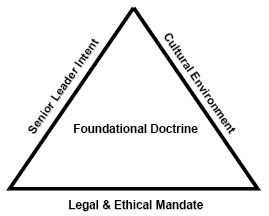 Foundational
Doctrine Foundational
Doctrine
[Foundational Doctrine] applies to the overall mission of the organization.
Foundational doctrine is the body of principles, the foundation of judgment,
decision-making, and behaviors that guides the actions of the organization
and describes the environment in which they are taken. It is developed
from the legal and ethical mandate of the organization, and the intent
of its senior leaders. Foundational doctrine is dynamic and responsive
to the mandate of the organization and the times in which it is carried
out.
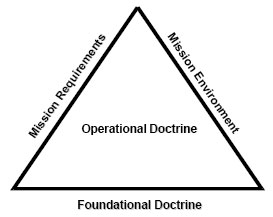 Operational
Doctrine Operational
Doctrine
provides guidance for dealing with the subjective, dynamic parts of
the mission element that rely on interpretation, judgment,
and agility. Operational doctrine is dynamic, and specifically
responsive to the requirements of the mission and the environment in which
it is performed.
The Difference Between Policy and Doctrine
Policy is the body of rules that guide the objective parts of the mission.
Rules do not require, nor do they benefit from interpretation
or discretion.
Foundational policy provides the structure and procedures necessary to
put the legal requirements of the organization into action. It is guided
by the law, and responds directly to it.
Operational policy encompasses those operational rules that senior leadership
determines are too important to leave to discretion, interpretation, or
judgment; they illustrate the “line that must never be crossed”,
and in application are not affected by the operational environment.
A Case for Doctrinal Review
It has been nearly 100 years since the first intentional
doctrine was established for fire “fighting”. This doctrine
was based on the culture-defining precedence of the 1910 fires. It clearly
stated fire was the enemy, a threat to the American way of life, “the
red menace” and that fire fighting was the moral equivalent of war.
From this doctrine (and the root metaphor behind it) the militaristic
culture of firefighting was born.
Several decades later the tragedy of Mann Gulch (1949) sparked reflection
and discussion on whether or not there was an acceptable human casualty
rate in this war on fire. In 1957, Forest Service senior leadership agreed
there was not, and the agency would henceforth fight fire aggressively
but provide for safety first. To enforce this standard the Forest Service
set forth a list of 10 standard orders that if followed would “reduce
the chances of men being killed by burning while fighting fire”.
The thinking that lead to the adoption of these “rules of engagement”
demonstrated a fundamental shift in firefighting doctrine at all levels.
The foundational doctrine (human life is more important
than the mission of fire suppression) altered the operational
doctrine of fire suppression forever, and the agency never paused
to review or consider the long-term implications beyond that point.
An equally profound shift in agency wildland fire suppression doctrine
was initiated in the landmark Report of the South Canyon Fire
Accident Investigation Team. The team cited failure to adhere
to the 10 Standard Fire Orders and proper “adherence” to the
18 “Watchouts” as a direct cause of the fatalities. Because
this seemed entirely rational (and simple), policy makers proclaimed that
the “orders are orders,” and began to use these rules of engagement
as a way to determine fault in subsequent fire related accidents. This
shift in foundational doctrine was to have profound impact on the Forest
Service for time to come.
The whispers of dissent (quieted by the very valid claim that the orders
were written in the blood of our fallen brethren) asserted that the 10
Standard Fire Orders were never intended to be used in such a way. It
was all too obvious that if all 10 Standard Fire Orders were followed
at all times, and if all hazards (“Watchouts”) were identified
and mitigated immediately, the chances of anyone “being killed by
burning while fighting fire” would be greatly reduced. That to evaluate
performance based upon these orders was akin to blaming the victim of
a fall from great heights as having ignored the law of gravity. It is
too obvious to have meaning or value, and doesn’t address the fundamental
human factors that lead to such errors.
This new doctrine was nevertheless codified within the Tri-Data report
and subsequent investigation reports and accident prevention plans resulting
from the Thirtymile and Cramer fire tragedies. Fireline performance expectations
and evaluation have become rules-driven, evolving over the last decade
into roughly 156 “inviolate” rules. Though the environment
and the mission require agility in decision-making, the firefighter’s
ability to adapt and react has become more constrained, and the probability
of “failure” increased proportionally.
Within this rules-based framework proper and improper behaviors and decisions
are identified solely by the adherence to or deviation from the rules.
Success in this system does not rely on appropriate decisions and behaviors,
but on the absence of bad outcomes. Since this absence is impossible in
the high risk world, when bad things happen more rules get made. As control
measures are increased, the ability to succeed is confined to an ever
shrinking playing field, bad outcomes still occur, efficiencies erode,
and senior leadership is progressively more frustrated.
To allow this trend to continue to evolve unchecked by rational deliberation
is dangerous. We must take the opportunity to deliberately and intentionally
craft doctrine, balanced with objective policy, that will guide the organization
in meeting its legal and ethical mandate to protect natural resources
and communities while first providing for firefighter safety.
How Will the Use of Doctrine Prevent Fireline Tragedies?
Sun Tzu, Von Clausewitz, and more recently, James Reason have all written
that principles, rather than prescriptive rules, are essential to successfully
operate within a dynamic environment, like wildland fire.
Doctrine relies upon, and requires initiative that is concentric with
the fundamental purpose of the organization. “…it’s
not a code of standardized procedures but a creative process.” Doctrine
is authoritative, but not overly restrictive…
Doctrine serves to focus the friction (and related decisions) between
theory and practice, between real and idealized mechanical processes.
“This [doctrine] will serve both as support to their judgment and
a barrier against those extravagant and erroneous views which are so especially
to be dreaded in a sphere where experience is so costly.” Doctrine
guides proper action and decision making...
Because of the friction (the difference between what was anticipated
and what turns out to be the on-the-ground reality) inherent in the wildland
fire environment, we can only hope to create a 70% plan (the so-called
“70% Solution”). To invest more time in trying to achieve
a perfect plan causes a loss of momentum, and, perhaps, opportunity. Operating
in an environment guided by clear and understood doctrine, the last 30%
of the plan is placed into the hands of the subordinates who are not only
empowered, but expected to exercise initiative in achieving the objective
expressed by the line officer. Doctrine bridges the gap between
the plan, and the execution of the plan in a dynamic environment...
An organization guided by well understood and shared operational doctrine
exhibits a workforce with well developed character and initiative, a workforce
that has good understanding of the mission of the agency and the intent
of its leadership. It relies on sharply honed judgment and decision-making
skills. Doctrine requires workforce attributes that make the organization
error resistant and efficient…
Well developed doctrine will provide more effective guidelines for decision
making within the subjective realm of human performance. (Transparency)
Doctrine will assist all functional areas associated with wildland fire
in providing:
— Priorities for funding and budget decisions
— Priorities for the allocation of training resources
— Improved tools to evaluate performance (where quantifiable
measurement is possible and appropriate and understandable guidelines
where evaluation must remain subjective)
— A workable framework to determine accountability and apply
discipline within the agency
— A clarified understanding of how different systems operate
together to accomplish the agency mission
— A tool to build and regain trust of external institutions
— Minimize conflicting expectations by formalizing the way that
FAM adds value to the overall FS mission
What Will it Look Like?
There will be a transparent and clearly defined separation between doctrine
(the body of knowledge used by fireline leaders to develop and apply subjective
judgment to achieve success in wildland fire suppression operations) and
policy (those rules, requirements, regulations, laws… that are considered
so critical that limitations and constraints are required, and the authority
to deviate is reserved at higher levels). There will be clear guidance
on how the two are to be applied, and how they support one another.
There will be a visible and understood framework and system for presenting
doctrine in a streamlined and coherent form to the field.
There will be a system and process to establish the relationships and
linkages between doctrine, executive vision, agency mission, training,
support, operations, administration, and so on.
There will be a visible process and infrastructure for the ongoing evaluation,
review, revision and distribution of doctrine within the agency.
Quality assurance processes and measures will be transparent, well understood
and embraced, and effective at treating upstream issues prior to bad outcomes.
In Summary
While it is entirely appropriate that there be rules for those things
that cannot be left to judgment, discretion, and interpretation…
the “lines that must never be crossed”… success in accomplishing
the dynamic, often un-quantifiable elements of any mission or purpose
rests upon subjective and reasoned decisions made by men and women skilled
and experienced in the application of operational doctrine to accomplish
them. Policy alone cannot support that outcome. The core operating system
of any organization requires a solid, integrated framework of doctrine
and policy operating in tandem (See Figure 1).
General References
Applegate, R.A.D. and J.R. Moore, "Warfare - An Option of Difficulties:
An Examination of Forms of War and the Impact of Military Culture"
The RUSI Journal (Autumn 1990), p. 16.
Department of Defense, Department of Defense Dictionary of Military
and Associated Terms, Pub 1-02 (Washington: Office of the Joint Chiefs
of Staff, 1989), p. 118.
Holdsambeck, Steve, USDA Forest Service, Inter-Mountain Region, personal
correspondence, March, 2005.
Hughes, Wayne P., “Fleet Tactics: Theory and Practice”,
Annapolis, MD: Naval Institute Press,1986, p. 28.
Keithly, David M., and Stephen P. Ferris, “Auftragstaktik,
or Directive Control, in Joint and Combined Operations”, from
Parameters, Autumn 1999, pp. 118-33.
Kirkland, Faris R., Ph.D., Lieutenant Colonel (USA, Retired), “Auftragstaktik
- How U.S. Army officers disgruntled by the culture of ‘looking
good’ and ‘ticket-punching’ survived the system, became
generals and created a revolution in military leadership”
McKenzie, Major Kenneth F. Jr., United States Marine Corps, “The
Importance of Doctrine”.
Reason, James , “Managing the Risk of Organizational Accidents”,
Ashgate Publishing, December, 1997.
Silva, Lieutenant Colonel John L., “Auftragstaktik – Its
Origin and Development”, Infantry, Sept-Oct 1989, p. 6-9
(excerpts)
Smith, Mark, Mission-Centered Solutions, personal correspondence, 2004-2005.
Weick, Karl, and Kathleen Sutcliffe, “Managing the Unexpected:
Assuring High Performance in an Age of Uncertainty”, Jossey-Bass,
July, 2001.
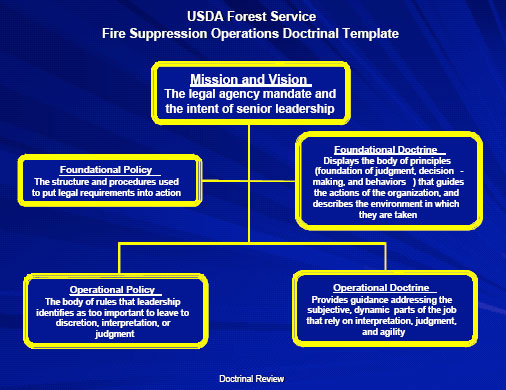
|
